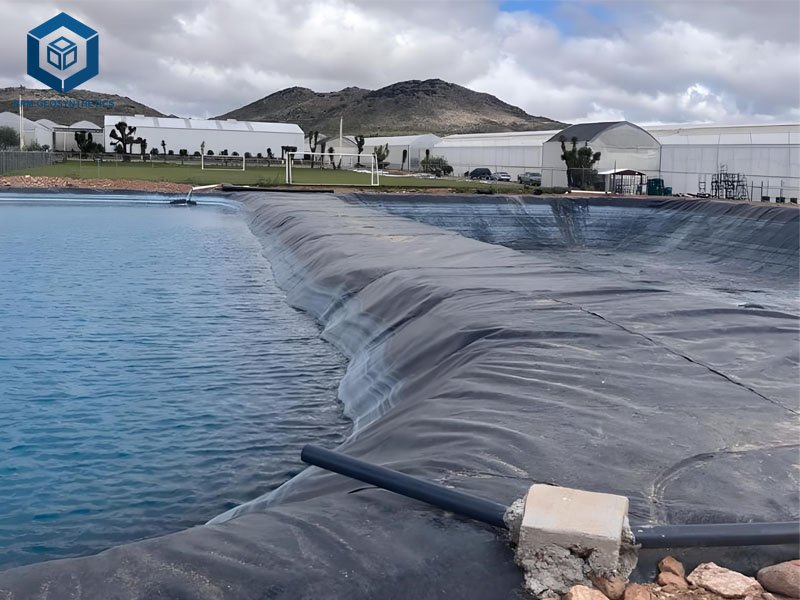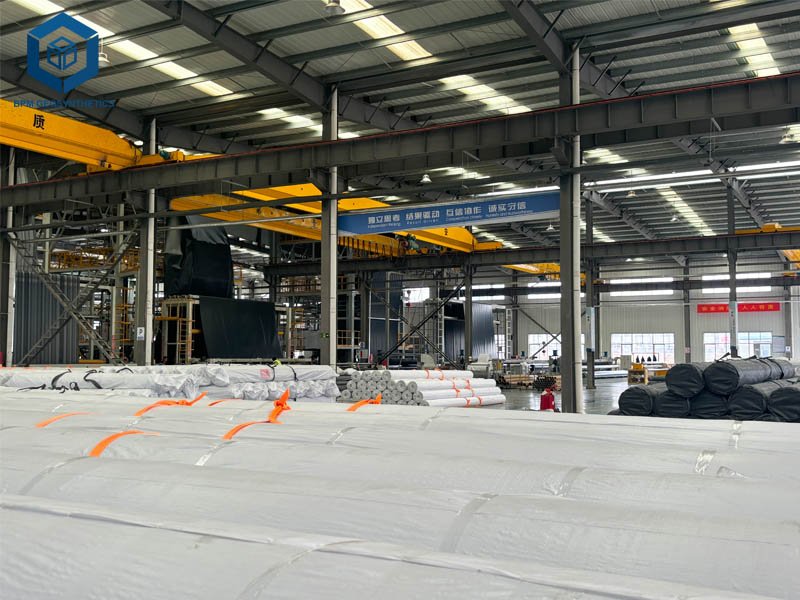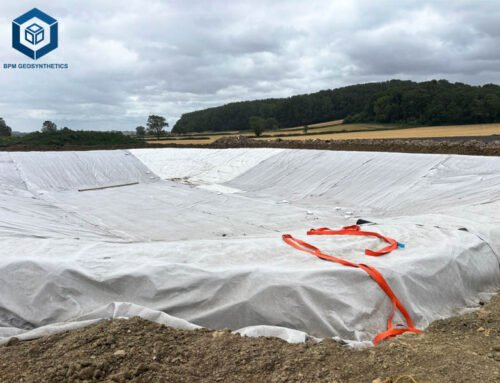In the realm of landscape design and water management, pond liners serve as the foundational element ensuring water retention, structural integrity, and environmental protection. As a critical component in applications ranging from serene backyard koi ponds to expansive aquaculture farms and stormwater retention basins, the selection of an appropriate pond liner directly influences both project success and long-term operational efficiency. With the global geomembrane market—encompassing pond liners—valued at $2.57 billion in 2024 and projected to reach $4.24 billion by 2030 at a compound annual growth rate (CAGR) of 8.6%, understanding pricing dynamics is essential for homeowners, landscapers, engineers, and facility managers alike. This guide delves into the intricacies of pond liner cost per square foot, providing data-driven insights, material comparisons, and practical recommendations to empower informed decision-making.
The question of “how much does a pond liner cost per square foot?” arises frequently in project planning, as costs can vary dramatically based on material type, thickness, project scale, and ancillary factors such as installation and maintenance. According to aggregated 2025 industry data from sources including HomeGuide, Angi, and BPM Geosynthetics, average material costs range from $0.28 to $5.00 per square foot, with fully installed systems escalating to $0.50 to $6.50 per square foot. These figures reflect not only raw material pricing but also the broader economic implications, including potential savings from bulk procurement (up to 20-30% discounts for orders exceeding 10,000 square feet) and the long-term value derived from durable installations that minimize leakage and repair expenses.
For instance, a modest 500-square-foot residential pond might incur material costs of $140 to $2,500, while a 1-acre (43,560 square feet) commercial installation could total $12,197 to $217,800 in materials alone, excluding labor and site preparation. Such variability underscores the importance of a nuanced approach to budgeting. This article will systematically explore pond liner fundamentals, dissect cost influencers, compare material options with technical specifications, offer selection strategies, and highlight emerging trends to equip you with the knowledge needed for a cost-effective, resilient pond project.
1. What Are Pond Liners?
Pond liners are impermeable barriers, typically fabricated from synthetic polymers or natural composites, designed to contain water within excavated or constructed basins while preventing seepage into surrounding soils. These geosynthetic materials function as hydraulic seals, safeguarding groundwater from contamination and maintaining optimal water levels for ecological balance. In essence, they transform irregular earthworks into functional aquatic ecosystems, supporting diverse applications from ornamental water gardens to industrial reservoirs.
Key Applications of Pond Liners
Pond liners find utility across a spectrum of scenarios, each demanding specific performance characteristics:
- Residential and Ornamental Ponds: Ideal for koi habitats, water gardens, and cascading features, where aesthetic integration and fish safety are paramount. These liners must resist UV degradation and support biofilm development for natural filtration.
- Aquaculture and Fish Farming: In tilapia or trout operations, liners ensure water quality and prevent escapement, with non-toxic formulations critical to aquatic health. A 2024 study by the Geosynthetic Institute noted that properly installed liners in fish ponds achieve 95% water retention efficiency, reducing evaporation losses by up to 80%.
- Agricultural and Irrigation Reservoirs: For crop irrigation or livestock watering, liners mitigate soil erosion and conserve resources, particularly in arid regions where water scarcity amplifies cost implications.
- Stormwater Management and Retention Basins: Engineered liners in urban developments control runoff, complying with environmental regulations such as those from the U.S. Environmental Protection Agency (EPA), which mandate low-permeability barriers (less than 1×10⁻¹⁷ cm/s) to prevent pollutant migration.
- Mining and Industrial Tailings Ponds: High-strength liners withstand chemical exposure and mechanical stress, extending service life in harsh conditions.
Essential Specifications for Pond Liners
To evaluate suitability, consider these core parameters, standardized under ASTM International guidelines:
- Thickness: Measured in mils (1 mil = 0.001 inch), ranging from 20 mil for lightweight applications to 80 mil for heavy-duty industrial use. Thicker liners enhance puncture resistance but increase costs by 20-50%.
- Tensile Strength: Typically 8-40 kN/m (ASTM D6693), indicating resistance to stretching under load. Higher values (e.g., 30 kN/m for HDPE) suit sloped terrains prone to shear forces.
- Elongation at Break: 100-700% (ASTM D6693), measuring flexibility; vital for conforming to irregular pond contours without cracking.
- Puncture Resistance: Expressed in Newtons (ASTM D4833), with values exceeding 300 N recommended for rock-lined installations to avert tears during placement.
- Permeability: Ultra-low at 1×10⁻¹⁴ to 1×10⁻¹⁷ cm/s (ASTM D5887), ensuring minimal leakage—equivalent to less than 0.1 gallon per acre-foot per day.
- UV Resistance: Critical for exposed sections; materials like RPE maintain integrity for 20+ years under direct sunlight, per accelerated weathering tests (ASTM G155).
- Chemical Resistance: pH tolerance of 2-13 for EPDM, enabling use in acidic or alkaline environments without degradation.
These specifications not only dictate performance but also correlate directly with pricing. For example, a 30 mil liner with 20 kN/m tensile strength might cost $0.50 per square foot, while an 80 mil variant at 40 kN/m could exceed $3.00 per square foot. Selecting based on site-specific needs—such as soil pH, expected foot traffic, or wildlife interaction—optimizes both cost and longevity.


2. How Much Does a Pond Liner Cost Per Square Foot?
Pond liner pricing per square foot encapsulates a multifaceted equation influenced by material composition, dimensional attributes, and project logistics. In 2025, baseline material costs hover between $0.28 and $5.00 per square foot, per comprehensive analyses from HomeAdvisor and BPM Geosynthetics. When factoring in installation, underlayment, and ancillary expenses, totals can climb to $2.50-$9.00 per square foot for complete systems, as reported by HomeGuide for full pond constructions.
2.1 Pond Liner Cost Per Square Foot – Pond Liner Cost by Material Type
Material selection accounts for 40-60% of total expenses, balancing initial outlay against durability and maintenance savings. Below is a detailed breakdown of prevalent options, including average 2025 pricing, key specifications, and real-world applications.
2.1.1 High-Density Polyethylene (HDPE)
HDPE liners, derived from petroleum-based thermoplastic resins, dominate large-scale projects due to their robustness and cost-efficiency.
- Cost: $0.50-$3.00 per square foot, with bulk pricing as low as $0.14-$0.62 for virgin resin variants.
- Specifications: Thickness: 0.75-2.5 mm; Tensile Strength: 20-40 kN/m; Elongation: 12-20%; Puncture Resistance: 400-800 N; Lifespan: 20-60 years buried, 10-30 years exposed; Permeability: <1×10⁻¹⁷ cm/s.
- Advantages: Exceptional chemical and UV resistance (retains 90% integrity after 1,600 kJ/m² exposure, per ASTM G155); weldable seams reduce leak risks by 95%; lightweight (0.1-0.2 lbs/sq ft) for easier transport.
- Disadvantages: Stiffer than rubber alternatives, requiring skilled heat-welding (adds $0.30-$0.75/sq ft in labor); not ideal for highly irregular shapes without pre-fabrication.
- Applications and Example: Predominant in aquaculture (e.g., a 20,000 m² California tilapia farm saved $10,000 via bulk HDPE at $1.00/sq ft, achieving 40-year durability). Suppliers like BPM Geosynthetics and Solmax report 98% customer satisfaction for leak-free performance.
2.1.2 Ethylene Propylene Diene Monomer (EPDM)
EPDM, a synthetic rubber, excels in flexibility for contoured designs, though at a premium.
- Cost: $0.75-$2.00 per square foot; 45 mil standard at $1.00-$1.50.
- Specifications: Thickness: 0.75-1.5 mm (30-60 mil); Tensile Strength: 8-16 kN/m; Elongation: 300-500%; Puncture Resistance: 200-400 N; Lifespan: 30-50 years; Permeability: <5×10⁻¹⁴ cm/s.
- Advantages: Highly conformable (expands 300% without rupture); fish- and plant-safe (NSF-certified); simple adhesive seaming (reduces installation time by 20%).
- Disadvantages: Lower puncture resistance (requires underlayment, adding $0.25-$0.40/sq ft); heavier (0.3 lbs/sq ft), inflating shipping costs by 15-20%.
- Applications and Example: Backyard koi ponds; a 1,000 sq ft installation using Firestone PondGard (45 mil) cost $1,200 in materials, with users praising 27-year durability in Reddit reviews. Vendors like Natural Waterscapes garner 4.8/5 ratings for ease of use.
2.1.3 Polyvinyl Chloride (PVC)
PVC offers an economical entry point but trades longevity for affordability.
- Cost: $0.35-$1.50 per square foot; 20-30 mil at $0.40-$0.90.
- Specifications: Thickness: 0.5-1.0 mm (20-40 mil); Tensile Strength: 10-20 kN/m; Elongation: 200-400%; Puncture Resistance: 150-300 N; Lifespan: 10-15 years; Permeability: <1×10⁻¹³ cm/s.
- Advantages: Highly flexible for DIY installations; lightweight (0.05-0.1 lbs/sq ft); available in preformed shapes for small ponds.
- Disadvantages: Prone to UV brittleness (degrades 50% after 5 years exposed); potential plasticizer leaching (not always fish-safe); hardens in cold climates, increasing crack risk by 30%.
- Applications and Example: Small garden features; a 144 sq ft patio pond at $0.65/sq ft totaled $94, but required replacement after 8 years per HomeAdvisor user feedback. Affordable from Home Depot, though reviews note frequent repairs.
2.1.4 Reinforced Polyethylene (RPE)
RPE combines polyethylene with geotextile scrims for enhanced tear resistance.
- Cost: $0.40-$0.90 per square foot; 24-40 mil at $0.50-$0.75.
- Specifications: Thickness: 0.6-1.0 mm (24-40 mil); Tensile Strength: 15-30 kN/m; Elongation: 100-200%; Puncture Resistance: 500-700 N; Lifespan: 20-40 years; Permeability: <1×10⁻¹⁵ cm/s.
- Advantages: 2-3x more puncture-resistant than EPDM; half the weight (0.15 lbs/sq ft); 20-year UV warranty when exposed.
- Disadvantages: Less flexible for extreme contours; requires fusion welding for seams.
- Applications and Example: Irregular waterfalls; Everything-Ponds’ Classic RPE (30 mil) for a 150 sq ft feature cost $75, with 4.8/5 reviews for wrinkle-free installation.
2.1.5 Other Materials: Bentonite Clay and Concrete
- Bentonite Clay: $0.50-$3.00 per square foot (2-5 lbs/sq ft application); swells to seal naturally; eco-friendly for large ponds but labor-intensive (adds 20-30% to install costs). Lifespan: 20-50 years; ideal for sustainable projects.
- Concrete: $50-$130 per square foot installed; permanent but high-maintenance (30% more in cold climates); suited for formal pools.
2.2 Pond Liner Cost Per Square Foot – Cost Impact of Thickness
Thickness directly correlates with durability and price, escalating 10-20% per 10 mil increment:
- 20-30 mil: $0.28-$1.00/sq ft; suitable for small, low-traffic ponds (e.g., 1,000 sq ft at $420 total).
- 40-60 mil: $0.75-$2.00/sq ft; standard for residential use, balancing cost and strength.
- 80+ mil: $2.00-$5.00/sq ft; industrial-grade, reducing puncture incidents by 50% but adding weight.
Data from BTL Liners indicates 45 mil EPDM saves $5,000-$20,000 over 20 years in a 10,000 sq ft pond via fewer repairs.
2.3 Pond Liner Cost Per Square Foot – Project Size and Scale Effects
Economies of scale drive down per-unit costs:
- Small Ponds (<500 sq ft): $1.00-$3.50/sq ft (no bulk discounts; higher labor ratio).
- Medium (500-5,000 sq ft): $0.50-$2.00/sq ft.
- Large (>5,000 sq ft, e.g., 1 acre): $0.28-$1.50/sq ft (20% savings); a 43,560 sq ft HDPE liner totals $21,780-$130,680.
Custom fabrication adds 5-10%, but minimizes seams (reducing leaks by 15%).
2.4 Pond Liner Cost Per Square Foot – Installation Method and Labor Costs
Installation comprises 20-30% of budgets, varying by technique:
- DIY: $0.50-$2.00/sq ft materials + $50-$200 tools; feasible for <1,000 sq ft but risks 25% lifespan reduction from errors.
- Professional: $40-$150/hour ($0.30-$0.75/sq ft for welding); total $1,000-$7,400 for average projects. Rocky soils inflate costs 15-20% due to underlayment needs.
- Methods: Heat-welding (HDPE/RPE: durable seams); adhesive (EPDM: quicker but $0.10/sq ft extra).
Site conditions like slopes (>20% grade) add $0.20/sq ft for anchoring.
2.5 Pond Liner Cost Per Square Foot – Raw Material Quality and Additives
Virgin resin liners cost 10-20% more than recycled but offer 95% higher quality assurance (per Geosynthetic Institute). UV stabilizers and antioxidants add $0.05-$0.15/sq ft, extending life by 10-15 years.
2.6 Pond Liner Cost Per Square Foot – Transportation and Logistics
Shipping: $0.05-$0.10/sq ft for HDPE; EPDM’s weight hikes 20%. Local sourcing (e.g., Pondliner.com) saves 10-15%.
2.7 Pond Liner Cost Per Square Foot – Maintenance and Lifetime Costs
Annual upkeep: $0.01-$0.05/sq ft (inspections, cleaning); HDPE’s low-maintenance yields 20-30% savings over PVC. Failure costs $1,000-$5,000 per incident; durable liners amortize to $0.02-$0.06/sq ft annually over 40 years.
3. How to Choose the Right Pond Liner
Selecting an optimal pond liner requires aligning technical requirements with budgetary constraints. Begin by mapping project demands—pond volume, soil composition, and usage intensity—to specifications like those in ASTM D5887.
3.1 Assess Project Requirements
Match applications to materials:
- Aquaculture: 0.75-1.0 mm HDPE ($0.62-$1.20/sq ft) for chemical resistance.
- Ornamental: 45 mil EPDM ($1.00/sq ft) for flexibility.
- Large Retention: RPE or bentonite ($0.40-$2.50/sq ft) for scalability.
Calculate needs: Liner Area = (Length + 2×Depth + 2 ft) × (Width + 2×Depth + 2 ft). Add 10-15% for overlaps.
3.2 Prioritize Quality and Certifications
Opt for NSF/ANSI 61-certified liners to ensure fish safety and regulatory compliance. Avoid recycled materials for potable applications, as they may leach contaminants (up to 20% impurity risk). Warranties (20-50 years) from suppliers like BPM underscore reliability.
3.3 Evaluate Installation Needs
For DIY, choose flexible PVC/EPDM; professionals favor weldable HDPE. Underlayment ($0.25/sq ft) is non-negotiable for puncture-prone sites, per industry best practices.
3.4 Consider Long-Term Costs
Invest in durability: A $0.75/sq ft EPDM liner saves $0.03 annually over 30 years versus $0.35 PVC (requiring 2-3 replacements). Lifecycle analysis favors HDPE for ROI exceeding 200% in commercial settings.
3.5 Compare Suppliers and Obtain Quotes
Reputable providers include BPM Geosynthetics (HDPE specialists, 4.9/5 Alibaba ratings), Everything-Ponds (RPE, praised for custom sizing), and Home Depot (PVC, accessible but basic). Request samples and quotes for 5-10% variances; bulk from Lonestar Minerals yields bentonite savings.


4. Industry Trends Affecting Pond Liner Costs
Evolving market dynamics are reshaping pricing in 2025:
- Raw Material Fluctuations: Petroleum volatility (up 15% YoY) elevates HDPE/PVC costs, per Research and Markets; recycled resins mitigate by 10-15%.
- Sustainability Push: Bentonite and bio-based liners gain traction, with EPA incentives reducing effective costs by 20% for green projects.
- Wider Roll Widths: Up to 50 ft from JustPondLiners.com minimizes seams, cutting installation by 15% ($0.10/sq ft savings).
- Smart Integration: IoT sensors for leak detection add $0.05/sq ft upfront but slash maintenance 30%.
- Supply Chain Localization: U.S. manufacturers like Western Environmental Liner report 10% lower logistics, benefiting domestic buyers.
These trends signal a shift toward eco-durable, tech-enhanced liners, potentially stabilizing prices at $0.40-$2.50/sq ft by 2030.
5. Conclusion
Navigating pond liner costs per square foot demands a strategic blend of technical acumen and economic foresight. From HDPE’s cost-effective resilience ($0.50-$3.00/sq ft) to EPDM’s flexible longevity ($0.75-$2.00/sq ft), each material offers tailored value propositions backed by rigorous specifications like 20-40 kN/m tensile strength and sub-10⁻¹⁷ cm/s permeability. By accounting for thickness, scale, installation ($0.30-$0.75/sq ft labor), and maintenance ($0.01-$0.05/sq ft annually), projects can achieve 95% retention efficiency while saving $5,000-$20,000 per 10,000 sq ft over decades.
For optimal outcomes, prioritize certified suppliers, leverage bulk discounts, and align choices with site-specific needs—whether a tranquil garden oasis or a robust farm reservoir. Investing wisely today ensures enduring functionality and aesthetic appeal tomorrow. For customized quotes, specifications, or expert consultations, reach out to leading providers like BPM Geosynthetics to elevate your pond project with precision-engineered solutions.





